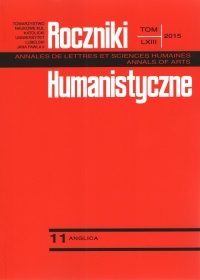America of future past: the post-apocalyptic chronotope of Jim Crace’s The Pesthouse
Abstrakt
Ameryka prz(y/e)szłości. Chronotop postapokaliptyczny w powieści The Pesthouse Jima Crace’a
Artykuł analizuje związki czasoprzestrzenne w powieści współczesnego brytyjskiego pisarza Jima Crace’a (1946–) The Pesthouse (2007) w oparciu o ustalenia metodologiczne Michaiła Bachtina dotyczące literackiego chronotopu. Autorka wychodzi z założenia, że dominujący w powieści chronotop postapokaliptyczny opiera się na dynamicznej relacji dwóch chronotopów gatunkowych – utopijnego i dystopijnego – które jednocześnie dekonstruują i odbudowują amerykański mit Objawionego Przeznaczenia. Topos „miasta na górze”, łączący przeszłość i przyszłość Ameryki jako Edenu i Nowej Jerozolimy, w powieści Crace’a przyjmuje postać tytułowego domu zarazy (pesthouse), miejsca choroby i ozdrowienia bohaterki powieści, jak również, w podtekście, odrodzenia zdegenerowanej wizji amerykańskiej utopii. Ostatecznie, jak wnioskuje autorka, The Pesthouse jest wyrazem rewizjonistycznej nostalgii (w rozumieniu Jamesa Bergera), w której traumatycznej ingerencji przeszłości w teraźniejszość towarzyszy utopijny impuls.
Bibliografia
Bakhtin, Mikhail Mikhailovich. “Forms of Time and of the Chronotope in the Novel: Notes toward a Historical Poetics”. The Dialogic Imagination: Four Essays. Trans. Caryl Emerson and Michael Holquist. Ed. Michael Holquist. Austin: University of Texas Press, 1985. 84–258.
Balée, Susan. “Jim Crace’s Violent Verities”. The Hudson Review 60.3 (2007): 517–27.
Bemong, Nele, and Pieter Borghart. 2010. “Bakhtin’s Theory of the Literary Chronotope: Reflections, Applications, Perspectives”. Bakhtin’s Theory of the Literary Chronotope: Reflections, Applications, Perspectives. Ed. Nele Bemong, Pieter Borghart, Michel De Dobbeleer, Kristoffel Demoen, Koen De Temmerman and Bart Keunen. 3–16.
Berger, James. “Cultural Trauma and the ‘Timeless Burst’: Pynchon’s Revision of Nostalgia in Vineland.” PMC 5.3 (1995): no pag. Muse. Web. 22 Oct. 2015.
Caldwell, Wilber W. American Narcissism: The Myth of National Superiority. New York: Algora Publishing, 2006.
Crace, Jim. The Pesthouse. London: Picador, 2007.
Edwards, Caroline. “Microtopias: The Post-Apocalyptic Communities of Jim Crace’s The Pesthouse.” Textual Practice 23.5 (2009): 763–786.
Ferns, Chris. Narrating Utopia: Ideology, Gender, Form in Utopian Literature. Liverpool: Liverpool University Press, 1999.
Kolbuszewska, Zofia. The Poetics of Chronotope in the Novels of Thomas Pynchon. Lublin: The Learned Society of the Catholic University of Lublin, 2000.
Moylan, Tom. Scraps of the Untainted Sky: Science Fiction, Utopia, Dystopia. Boulder, Colorado: Westview Press, 2000.
Sargent, Lyman Tower. “The Three Faces of Utopianism Revisited.” Utopian Studies 5.1 (1994): 1–37.
Slotkin, Richard. 1975. Regeneration Through Violence: The Mythology of the American Frontier, 1600–1860. Middletown, Connecticut: Wesleyan University Press.
Winthrop, John. 1979. “A Model of Christian Charity.” The Norton Anthology of American Literature. Shorter Sixth Edition. Ed. Nina Baym. New York, London: W. W. Norton & Company. 95–106.
Copyright (c) 2015 Roczniki Humanistyczne

Utwór dostępny jest na licencji Creative Commons Uznanie autorstwa – Użycie niekomercyjne – Bez utworów zależnych 4.0 Międzynarodowe.





